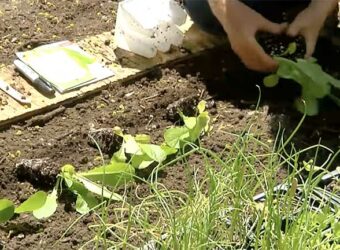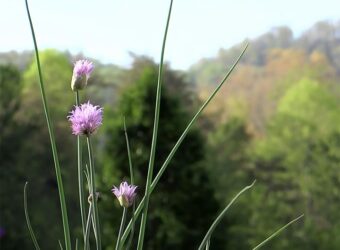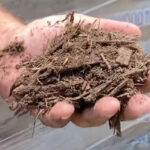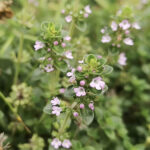Cucumbers have been grown as food for millennia – more than 3,000 years according to cave excavations. They have persisted as popular vegetables and are a favorite of backyard gardeners. Cucumbers were one of the top five garden vegetables in the US as of 2014 according to David Trinklein of the University of Missouri.
Unfortunately, many pests also find cucumbers to be a highly favorable food source. These vegetables used to defend themselves against insect attacks. You know that bitter taste that we dread that occasionally pops up in cucumbers?
Those foul-tasting chemicals are called cucurbitacins and are present in much larger amounts in cucumbers that have not been bred to serve as food. They are thought to be the plant’s way of repelling insects.
Now that cucumbers no longer produce these chemicals and cannot easily defend themselves against many pests, we need to do it for them (with the help of biological controls). Many of the major pests of cucumbers also attack other plants, while others (like cucumber beetles) are more specialized for these vegetables.
Here are the main 14 pests of cucumbers and ways to control them:
- Aphids
- Armyworms
- Cucumber beetles
- Cutworms
- Darkling beetles
- Flea beetles
- Leafminers
- Loopers
- Pickleworms
- Seedcorn maggots
- Squash bugs
- Thrips
- Two-sided spider mites
- Whiteflies
Aphids
Melon aphid – Aphis gossypii
Green peach aphid – Myzus persicae
Many types of aphids feed on cucumbers, but melon and green peach aphids are the main culprits.
It can be difficult to distinguish between different types of aphids, but they cause comparable types of damage. Fortunately, similar techniques are used to control different types of aphids.
All types of aphids are tiny insects about 1/16 inch (1.6 mm long). They can either have wings or be wingless. They have two tubular structures (“cornicles”) sticking out of their abdomen.
Damage
These aphids suck the plants’ sap from the bottom of the leaves. You can tell when the leaves are damaged because they look distorted and cupped.
Heavy infestations can cause the leaves to look mottled or have spots of dead tissue on them. They can cause infested plants to be stunted.
Another very common problem from aphid infestation is a fungal infection called sooty mold in which a fungal infection of the leaves below causes them to turn brown. This will not kill the plants, but it can weaken their ability to produce energy by photosynthesis and reduce yields.
Not only can the aphids themselves severely damage cucumbers, they can also transmit viruses that can greatly reduce the yields of the infected plants.
This is a particularly serious threat because it only takes a few seconds of feeding for an aphid to transmit a virus to a plant. Even if the aphid dies immediately, it could still have infected the plant.
Lifecycle
These insects survive the winter as eggs on perennials. These eggs hatch in the spring and release wingless females. Female aphids can lay eggs without the need to mate (asexual), and they will produce 1 or 2 generations on the host they are on.
However, in late spring, they migrate to cucumbers or other plants that they feed on the bottom of leaves. They continue reproducing asexually and produce several generations of both winged and wingless aphids.
At the end of the season, they migrate back to the host they will overwinter on, mate, and lay eggs that will hatch the next spring.
Check your cucumber plants for aphids
Agricultural specialists call this practice “scouting.” Periodically examine the bottoms of the leaves on your cucumber plants for aphids.
What you will do next depends on whether natural predators are helping to keep them in check.
Look for ladybugs and lacewings around the colonies of aphids. Check for both the larval and adult stages of these beneficial insects.
Next, look to see if parasites have attacked the aphids. You can tell by looking for “mummy aphids” that have been parasitized by other organisms.
Such aphids will be tan and two to three times larger than normal aphids.
Keep an eye on the plants, and if the colonies of aphids are not increasing, you don’t need to take further action.
Management
If you purchase cucumber vines to plant, check them for aphids first.
You can use silver reflective mulches to deter the aphids. They will be much less likely to infest your plants.
Another step you can take is to plant dill, which is thought to protect cucumber plants from aphids.
If you do see aphids on your plants, try knocking them off with a blast of water from a hose.
Plants usually tolerate aphid infestations, but if your plants do have a lot of aphids, you should consider other treatments, such as neem oil or horticultural oil.
You are not likely to need to use synthetic insecticides to treat aphids in a backyard garden.
Armyworms
Spodoptera species
Armyworms are caterpillars that can lay waste to plants. They get their name because they hatch en masse and feed in groups. That is one way to distinguish them from loopers and corn earworms.
These widespread pests have infested six continents, so they are problems throughout the US and Canada.
Damage
Armyworms feed on the leaves of cucumber plants, and in worse case scenarios, can completely defoliate the plants. They can even “skeletonize” the leaves. This is the technical term for eating all the leaf tissue leaving only the veins.
These caterpillars will sometimes also eat the cucumbers, causing visible gouges in them. Older larvae are more likely to attack the fruit.
Appearance
The moths are mottled gray and brown. All the armyworm caterpillars have smooth skin. The bright green beet armyworm caterpillars are about 1 inch (25 mm) long and have distinctive stripes.
Lifecycle
The moths lay their eggs in fluffy masses on the leaves of older plants and the crowns of seedlings. After the eggs have hatched, the caterpillars feed together, but they gradually disperse as they get older.
The larvae form pupae on or right below the soil surface in a cell.
These pests produce multiple generations a year – three to five in California. It takes about a month for each lifecycle to be completed in warm weather.
Management
You should be able to control an armyworm infestation without the use of insecticides unless your seedlings are infested with many caterpillars.
- Handpicking
This classic method of controlling larger caterpillars works well with armyworms. Just pluck them off your cucumber plants.
If you are like I am and find the idea of squashing them to be gross, you can dispose of them by dropping them in a bucket of soapy water.
- Beneficial insects (predators)
Let cry the dogs of war! Or to be specific to cucumbers, unleash beneficial insects like ladybugs and lacewings. They can be highly effective against the caterpillars.
- Bacillus thuringiensis kurstaki (BTk)
You may not need to use this treatment unless you have a severe infestation.
These bacteria are specialized to infect caterpillars and are usually very effective at controlling them. One formulation suitable for backyard gardens is Bonide® Thuricide.
- Spinosad
Several types of this insecticide are certified organic. One common formulation is Bonide® Captain Jack’s Deadbug BrewTM Dust.
Cucumber Beetles
Spotted cucumber beetle (Diabrotica undecimpunctata)
Striped cucumber beetle (Diabrotica balteata)
Cucumber beetles feed on almost all parts of their hosts – the leaves, flowers, vines, cotyledons, and the rind of fruits. They attack the cucumber plants as soon as they emerge from the ground and either kill them or dramatically slow their growth.
It gets worse! It is not clear how widespread this is, but observers in South Carolina have noted the beetles entering cracks in the soil to feed on seedlings below the soil surface.
And if that were not bad enough, they can infect your plants with the severe and frequently fatal disease bacterial wilt.
Appearance
Both species of these beetles are about 1/5 inch long and bright yellowish-green. As you could probably guess, spotted cucumber beetles have black spots, while the striped cucumber beetles have – you guessed it –stripes (alternating black and yellow).
Management
Techniques to control these infestations range from prevention – using row covers and eliminating weeds – to insecticides. If you only have a few cucumber plants in your garden, hand picking should be an option.
Given the critical nature of cucumber beetle infestations, we will provide more information on their control in a separate article.
Cutworms
Few pests are more heartbreaking than cutworms. Imagine going out to your garden to check on the progress of your cucumber seedlings to find that they have been severed at the soil line. Unfortunately, that nightmare is all too commonplace.
Appearance
There are many different types of cutworms, but they all cause the same damage. The caterpillars can have many different patterns and colors that help them blend well with the soil. These pests are usually 1-2 inches (2.5-5 cm) long with smooth skins.
A key characteristic is that they curl up into the shape of a C if you disturb them.
You can normally find cutworms on or just below the soil surface during the day and crawling around your plants at night.
Damage
Cutworms get their names for cutting plants down, but they can also chew holes in leaves. They also frequently eat partway through new shoots. They are primarily active in the spring.
Management
Prevention
- Keep your garden free of weeds in the winter
- Destroy crop residues
- After harvest
OR
- At least two weeks before planting
- Protect your seedlings
- Put cardboard collars around the stems of your seedlings
- Spread diatomaceous earth around the base of the plants. This will cut the insects if they crawl over it. One option is Perma-GuardTM Crawling Insect Control.
- Plant more cucumber plants than you need in case of losses
Prowl your garden at night
Since cutworms are active at night, going out at night with a flashlight and picking the caterpillars off the soil and killing them can be highly effective.
Darkling Beetles
Blapstinus species
Coelus species
In a nice change of pace, darkling beetles are rarely a problem on cucumbers. The exception is if there are large populations when the plants are seedlings. In this case, they can girdle young plants or cut them off at or below the surface of the soil.
However, these beetles are typically not a problem when the plants have grown to 5 or 6 inches (12.7 to 15 cm) tall.
Appearance
The beetles range from 0.13 to ¼ of an inch long (3 to 6 mm) and can be black, rusty brown, or bluish black.
They are commonly confused with predatory ground beetles, which are a good thing to have! These beetles eat other insects, including pests that live in the soil.
You can tell them apart by their antennae. Those of darkling beetles are clubbed, while those of predatory ground beetles are not.
The larvae look like wireworms and live in the soil – leading to their common name of “false wireworms.” They are dark brown to light yellow and tiny – 0.03 to 1/3 inch (1-8 mm) long.
Management
Fortunately, cultural control methods can minimize their damage:
- Keep your garden free of weeds
- Reduce the amount of organic matter in your soil. Farmers do this by fallowing their fields, but this is not practical for a backyard garden.
Keep an eye out for migrations of these beetles if your garden is near alfalfa hay fields.
Flea Beetles
Epitrix species
You wouldn’t think that such tiny beetles could cause so much damage, but unfortunately, you would be wrong. Heavy populations of them can kill young cucumber seedlings.
Flea beetles are tiny and black – all less than 1/10 inch long (2.5 mm). However, they can be easily detected because they jump around – like fleas! They also have highly enlarged back legs.
The damage from flea beetles is characteristic – many small holes on the leaves that look like they have been shot. This damage is technically called “shot-hole.”
Lifecycle
These beetles spend the winter in weeds or debris and lay tiny eggs in the spring. They primarily lay them in the soil or on the leaves. They can also lay them in hollowed cavities in the stem.
The slender white larvae look like worms and usually feed on the leaves. After a month or so, the larvae pupate in the soil.
They can go through several generations a year depending on the climate.
Management
Prevention is the main way to prevent damage from these pests.
- Remove plant debris in the fall
This will remove areas that the beetles can use to overwinter in your garden.
- Plant seeds early
Flea beetles are less likely to infest mature plants, so starting them early can give them a heads up.
- Use floating row covers
If you think that flea beetles will be a problem, you can protect your cucumber plants with floating row covers.
- Place reflective mulches very soon after planting
You can purchase these at your local garden center or online.
- Plant a trap crop
This involves planting a plant that will lure the pests to it and away from your cucumber plants. Crucifer plants like cabbage, broccoli or mustard are effective at attracting flea beetles.
If you do find flea beetles infecting your plants, you have several options in addition to using traditional insecticides.
- Spray them with neem oil
- Apply diatomaceous earth
Leafminers
Species of Liriomyza
Leafminers practically announce their infestation on your cucumber plants. As their name suggests, the 1/8 inch (3.2 mm) long larvae of these insects tunnel (“mine”) between the layers of the leaves, causing damage in their wake.
Fortunately, this damage usually has little effect on vegetable plants, so if you see them on your cucumber plants, you do not need to worry too badly. Mining typically has little effect on the growth of plants.
Also, these insects are native to North America, which has given other insects plenty of time to evolve the ability to use them as a food source. These insect predators usually do a good job of keeping these pests under control.
Lifecycle
Leafminers only live for two weeks at a time. The females are small flies with yellow bodies. They lay eggs in the leaves, and the larvae feed there until they drop to the ground to pupate.
There are many as five to 10 generations a year. Leafminers are pests of many types of plants, and the populations will migrate to different hosts throughout the year.
Management
As noted, your cucumber plants will probably be fine if they have some leafminer damage.
Keeping your plants vigorous by irrigating them will help to prevent infestation by these insects.
If older leaves do get infested, just clip them off.
If you have a history of large infestations of leafminers in your garden, you can use floating row covers in the spring to keep the insects off your cucumber plants.
Loopers
Trichplusia ni
Widely known as a pest of cabbage and other crucifers, the caterpillars of this insect have a wide host range and can cause extensive damage to the leaves of cucumbers.
You can identify this insect by the way it moves as strange as that may sound. These pests are called loopers because of the way the caterpillars arch their body as they move.
Lifecycle
The caterpillars are pale green and have white lines that run down either side of their body.
The dark moths lay white or pale green eggs singly usually on the bottoms of the leaves next to the leaf margin.
The caterpillars form pupae in crop debris in soil during the fall.
Management
This is another insect that is usually kept in check by its natural enemies. It is relatively easy to control if it does become a problem.
You should avoid using insecticides to control it. That can make things worse by killing off the natural predators that help to control the loopers.
You do have options:
- Hand pick the caterpillars
Either squash them or put them in a bucket of soapy water.
- Apply BTk
This is usually highly effective at controlling the young larval stage of these pests.
Pickleworm
Diaphania nitidalis
Pickleworms are caterpillars that can severely damage cucumbers and other members of the cucurbit family, particularly pumpkins, cantaloupes, and winter squash.
Fortunately for northern gardeners, pickleworms are creatures of the South, including Florida and Texas and forays into South Carolina in the spring.
Damage
These pests will tunnel in cucumber stems, buds, and flowers, but regrettably, they prefer the cucumbers and do the most damage on those parts of the plant.
The most common sign of infestation is small holes in the cucumbers that will frequently have frass protruding from them. (Frass is the excrement of insects and usually looks like sawdust.)
Damaged cucumber fruit are not edible, and you may not even know your cucumber has been attacked until you cut it open and find tunnels.
Lifecycle
A pickleworm cycle starts with small eggs on the leaves that resemble grains of sand. The larvae first feed on flowers, buds, and tender terminals before soon moving to the cucumbers.
These caterpillars shed their skin four times before they reach full size at about ¾ inches long (1.9 cm). They start out yellowish-white with spots before their first molt and end up solid copper or green.
The larvae fold over part of a leaf and starts its pupal stage. The pupae are about ¾ inch (1.9 cm) long.
The yellowish-brown moths are active at night. Their wings have a distinctive purple sheen with white-yellow centers.
Management
You can try to prevent infestations by planting cucumber varieties that mature early.
Keep an eye out for the symptoms of this pest, and destroy fruit that are damaged. Also, look for folded sections of leaves, and crush them to kill any pupae that might be inside them.
If you know that the variety you are growing is susceptible to pickleworms, take preventative action with BTk or spinosad by spraying at the following intervals in the evening.
- BTK: 4 -7 days
- Spinosad: every 7 days
Seedcorn Maggot
Delia platura
Seedcorn maggots are the larvae of flies that are usually only a problem on germinating seeds and very small seedlings in cool, wet weather.
These flies look like houseflies and are grayish-brown.
They lay their eggs in the stems in cracks in the soil near the stems or directly at the soil line. The maggots burrow into the roots or germinating seeds.
Seedcorn maggots have 3-5 generations a year. However, only the first one is likely to be of economic importance.
The best strategy to manage this pest is to prevent infestations from occurring:
- Don’t use too much manure as fertilizer
- These pests prefer to lay their eggs in rich soil
- Purge weeds at least two weeks before planting your cucumbers
- Consider planting transplants seeds that have been pregerminated
- Plant seeds under conditions that lead to rapid germination
- Monitor the temperatures of soil that is 4 inches deep
- Plant once they have reached 70ºF (21ºC)
- Cover your plantings with protective cloth or cover the individual plants to keep the flies from laying eggs near your cucumber plants
If your cucumber seedlings have been infested with these maggots, you can replant at these intervals depending on whether the maggots are greater or less than ¼ inch (6.3 mm):
- Greater than: 10 days
- Less than: 5 days
Squash bug
Anasa tristis
Squash bugs are one of the most troublesome pests of cucumbers in backyard gardens. They overwinter in protected shelters and are ready to strike at the advent of spring.
Both adults and nymphs suck the sap from cucumber vines and leaves. This can cause the leaves to turn black, and the whole plant to wilt and eventually die.
And if this damage were not bad enough, squash bugs are thought to transmit the cucumber disease yellow vine.
Appearance
The adult squash bugs are about 5/8 inches long (16 mm). They have a flat back, are speckled, and can be yellowish brown or grayish with orange or orange and brown with stripes. The nymphs lack wings and range from pale green to almost white.
Lifecycle
These pests produce several generations a year in warmer climates according the University of California IPM guide, while they only have one generation a year in South Carolina.
The squash bugs survive the winter in a diverse array of protected shelters, including vines, dead leaves, stones, and even buildings.
They appear slowly in the spring and mate.
The females lay 10-20 metallic eggs per egg mass on the stems or undersides of leaves – particularly in the angles caused where two leaves meet. The eggs are about 1/16 inches (1.5 mm) long.
The bodies of newly hatched nymphs are whitish green, while the legs and antennae are reddish brown. They lack wings.
The young nymphs feed very closely together and go through five stages before they become adults by the late summer or fall.
The older nymphs are grayish-white and have black antennae and legs.
Closely examine your cucumber plants
It is critical to detect the squash bugs as soon as possible because early detection can make the difference in whether you can control these pests.
Check your cucumber plants closely from the early season until flowering to determine whether they are infested with these insects.
Management
It is easier to control squash bugs in backyard gardens than in commercial fields.
- Pick off the adult bugs and nymphs and either squash them or put them in a bucket of soapy water.
- Search for and destroy the squash bug eggs in the spring and early summer.
- Put boards like old shingles or heavy cardboard under your vines at night. The squash bugs will cluster under them, and you should destroy them the next morning – either by stomping on them or using a hoe.
- Once you have harvested your cucumbers, remove all the plant debris and either compost it or bury it under the ground.
- Keep the areas around your cucumber plants free of piles of leaves, rubbish, boards, and other items that could serve as shelters for these insects.
Insecticides are not good at controlling squash bugs – particularly larger ones.
- Your best bet is to focus on controlling the tiny nymphs. Both neem oil and insecticidal soap can be used to control these small insects.
Thrips
Western flower thrips (Frankliniella occidentalis)
Onion thrips (Thrips tabaci)
Some types of thrips are predatory – and control other pests, including insects and mites. However, both onion thrips and western flower thrips are significant pests of cucumbers.
It can take an expert to tell which species has infested your plants, but fortunately, most species of thrips can be controlled in the same manner.
Damage
These tiny insects puncture the outer layer of the cucumber leaves and suck out the contents of the cells. This results in damage, such as discolored flecks, stippling (creating many small dots or specks), or causing the leaf surface to turn silver. They also leave trails of black frass (excrement) behind where they have fed.
The result is that the leaves, flowers, and surface of the fruits become discolored and scarred. The terminal ends of the plants can be distorted.
To make things even worse, both species of thrips can also infect your plants with tomato spotted wilt virus, a cucumber pathogen that can severely damage the plants. Once a thrip has been infected with this virus, it can transmit it for the rest of its life.
Appearance
You may need a magnifying glass to identify these insects because they are less than 1/20 inch or 1.5 mm long. The adults are light brown to pale yellow, and the nymphs are smaller, more lightly colored, and lack wings.
One characteristic feature of thrips is that there are long fringes of the margins of their wings.
Lifecycle
Thrips can complete their lifecycle within 2 weeks if the weather is warm and can have as many as eight generations a year.
The females lay eggs into or on the leaves or buds where the larvae feed. They go through two feeding stages and then develop into prepupae and pupae. They do not feed during these latter two stages.
The prepupae and pupae develop into adults in the soil or leaf litter, although they can also develop within crevices in the plants.
Determine whether your problem is thrips
There are two issues here.
- By the time you can see the damage that the thrips have caused, they may have moved on and could no longer be on your cucumber plants
- The damage could be due to other pests
• Mites and some true bugs also cause stippling on the leaves
• Some true bugs also produce the dark fecal specks that usually indicate an invasion of thrips.
Try to identify the thrips themselves before you plan your attack on them.
Management
Unfortunately, it can be difficult to control thrips.
You should be prepared to use an integrated program that combines several approaches:
- Effective cultural practices
- Introduction of natural enemies
- Insecticides that are the least toxic or most selective
Also factor in that thrips can be present without damaging your plants. For example, adults often feed on pollen.
Two-spotted Spider Mites
Tetranchyus urticae
Mites are tiny little arachnids that are 1/60 to 1/80 inches (0.42 to 0.32 mm) long. They are related to spiders, and the adults have eight legs.
While you might think that their small size would make them less of a threat, the opposite is true.
They can build up huge populations without your knowledge.
You might finally notice them when there are hundreds of mites per leaf. At this point, they are more difficult to control.
Damage
Fine webs are characteristic signs of all types of spider mites.
These mites live on the bottoms of leaves and rasp them to get the sap that they live on.
This can cause the leaves to turn yellow or gray, or they can appear speckled. Such damage can also affect the fruit.
Two-spotted spider mites can multiply to such high levels that they can kill your cucumber plants.
Heavy rains can reduce the damage
Such rains increase the humidity, which can make conditions more favorable for the growth of fungi.
While that may seem like a bad thing, in this case, it encourages the growth of fungi that kill the mites.
Another benefit of heavy rain is that can wash the mites off the leaves.
Insecticide use can increase the likelihood of mite infestation
You should be aware that your cucumber plants are more likely to be infested with two-spotted spider mites if they have been treated with insecticides.
That may seem odd, but there are many insects that naturally help to reduce the populations of spider mites, including lady bugs and minute pirate bugs. Insecticides also kill these natural enemies.
Management
There are some steps you can take that will help prevent mites from infesting your cucumber plants.
Prevention
- Remove weeds and debris
- Keep high relative levels of humidity
- Encourage beneficial insects by companion planting
- Good companion plants to protect cucumber plants include:
- Dill, which is thought to help protect against mites and aphids
- Oregano, which deters a range of pests
Check your plants regularly
If you find leaves that are yellow and speckled, closely examine them with a magnifying glass to determine if spider mites are present. The presence of webs strongly suggests that they are present.
You can distinguish two-spotted spider mites from other types of mites by the dots on their backs.
Conventional treatments
Commercial growers often use chemicals that are specialized to kill mites. These are known as miticides. However, you should be able to treat your cucumber plants with less harmful chemicals.
• Insecticidal soaps
If you realize that your plants are infested before the populations of mites get too high, you can use horticultural oil. Apply it twice five days apart.
Too much of this solution can burn the cucumber leaves, so use the lowest dose possible.
Avoid spraying your cucumber plants when the sun is shining on them directly or if they are stressed for water.
Other controls include:
- Neem oil
- A strong spray of water
Minute pirate bugs
These insects will seek out and feast on mites that infest plants.
While these predatory insects are often found naturally on infested plants, you can increase their population by purchasing large numbers of minute pirate bugs to release on your cucumber plants.
They prefer temperatures of 64 to 82ºF (18 to 28ºC).
Predatory mites
In a stroke of good luck for gardeners, there are predatory mites that eat other mites. You can harness them to help you rid your plants of two-spotted spider mites.
Different species of mites prefer varying temperatures, so you can select ones that are appropriate for the conditions of your garden.
- Galendromus occidentalis 80 to 110ºF 27 to 43ºC
- Mesoseiulus longipes 65 to 90ºF 18 to 32ºC
- Neoseilulus californicus 50 to 105ºF 10 to 41ºC
- Neoseilulus fallacis More than 64ºF More than 18ºC
- Phytoseiulus persimilis 68 to 90ºF 20 to 32ºC
Whiteflies
Sweetpotato whitefly – Bemisia tabaci
Bandedwing whitely – Trialeuodes abutilona
Most gardeners are familiar with whiteflies – those annoying clouds of tiny white insects that erupt after you have bumped a plant.
These insects can infest many types of plants and also spread diseases – especially viruses.
They seem generic to you, but there are about 1,200 different species of whiteflies throughout the world. Only two main culprits infest cucumbers.
However, these two species can be difficult to treat.
Lifecycle
Adult whiteflies are cream-colored or white insects that are 1/32 of an inch long (0.8 mm).
The females lay eggs that hatch into larvae called crawlers. These nymphs then go through three more steps of development before producing pupae that hatch into adult whiteflies.
Damage
While the adults are the most visible since they fly, nymphs cause the most damage.
You are unlikely to have problems from whiteflies unless there are nymphs.
Whiteflies on your cucumber plants can cause a myriad of problems.
- They suck the sap out of leaves and can kill them.
- They excrete a sugary substance called honeydew that falls to the leaves below and causes a fungal infection called sooty mold that can result in reduced yields.
- They can introduce highly damaging viruses to your cucumber plants.
- They can cause silver leaf disorder, which causes the leaves to develop silver spots.
Do not use an insecticide
If your first urge on seeing whiteflies is to reach for an insecticide, resist it!
Many whiteflies are resistant to insecticides. In this case, you would not be able to kill them.
The UC IPM guide to managing whiteflies states that most pesticides are not very effective at controlling them in gardens.
You could also make the situation much worse. Many predatory insects attack whiteflies, and the use of insecticides would kill them off.
One of the major reasons for whitefly infestations is that insecticides have been used and eliminated the insects that kept their populations in check.
Avoiding the use of such insecticides is considered to be “a very important aspect” of managing whitefly infestations.
Management
There are simple steps you can take that will help to knock down the populations.
As soon as you see whiteflies on your cucumber plants, spray them with your hose. You should be able to knock off many of them.
Next, remove plants or leaves that are heavily infested with larvae or pupae.
Doing so might reduce the populations of whiteflies to a level low enough that the natural predators could keep them in check.
Reflective mulches
Putting reflective mulches around your plants will help to deter whiteflies from colonizing them.
Another option is to use clear plastic mulch and spray it with silver paint.
Be sure to remove all the leaves before you place the mulch in your garden.
Yellow sticky traps
These specialized traps are often used to monitor the presence of particular insects in a garden or field.
When you are battling a whitefly infestation, you can use them to help reduce their populations.
Since whiteflies do not fly very far, you should place the traps near your cucumber plants. Put them level with the leaves that are infested and face the sticky side toward your plants.
Many of the insects will stick to the traps, which will eliminate them from your garden.
Biological control
Many common predatory insects can help to control whitefly infestations. These include lady bugs, lacewings, minute pirate bugs, and bigeyed bugs.
These predators are likely to already be in your garden, but you can purchase large amounts of them to provide even more control.
There are also parasites that live inside the whitefly larvae and kill them. You probably also have these types of insects in your garden.






